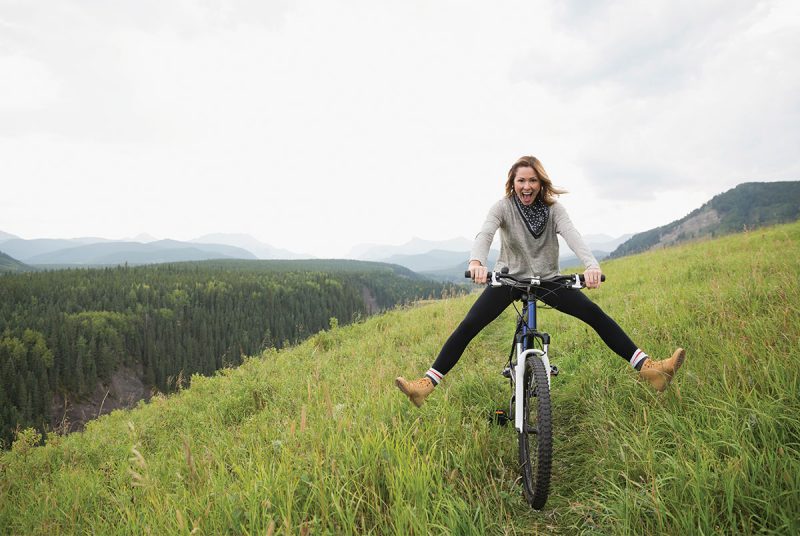Bikepacking is a new trend that combines exercise with an opportunity to explore unknown corners of the world
Can’t decide whether to hop on your bike or head for the hills for a hike? There’s now a way to enjoy both: Bikepacking. Part backpacking and part cycling, bikepacking is fast becoming a thing for biking buddies, couples and families that enjoy riding together. “Simply put, bikepacking is the synthesis of mountain biking and minimalist camping,” explains Logan Watts, a bikepacking enthusiast and head of bikepacking.com. And, with maps and apps just a click away, finding a route and a destination is a no-brainer.
Depending on how much time you have on your hands and your level of get-up-and-go, excursions range from local day trips and nearby overnighters all the way up to epic cross-country rides. Before packing up and pedaling off into the sunset, take a few tips from this rough and ready guide to what’s sure to become your latest obsession.
The Bike
If you own a bike and feel safe, secure and comfortable astride it, then you’re probably ready to transform it into a bikepacking dream machine. “There’s no need to go out and buy a fancy, new bike,” says Dan Meyer, staff writer at Adventure Cycling Association, a nonprofit organization committed to inspiring, empowering and connecting people to travel by bicycle. However, since most bikepacking trips lead to a campground, a mountain bike or something similar with relatively thick wheels is an ideal choice for cycling off-trail.
An avid bikepacker himself, Meyer likes a mountain bike with a steel frame. “It’s heavier, but it’s also more durable,” he says. Mechanical disc brakes and multi-position handlebars are recommended, and so long as storage bags can be easily mounted to your bike, you’re good to go.
Part backpacking and part cycling, bikepacking is fast becoming a thing for biking buddies.
The Gear
Bikepackers tend to carry the same type of “luggage” as backpackers, but instead of hoisting it all onto your back, you simply attach it to your bike. Specialized, compact bags are strapped to the frame, handlebars and seat, and can even be fastened to the wheels for those excursions that run long. Most bags are waterproof and many are made by hand in the U.S.
As for what to pack, in addition to everything you’d need for a traipse through the woods (like a sleeping bag, tent, stove and water), bikepackers take along a tire and tube repair kit, spare tubes and a multi-tool that includes a chain tool. Plus, a small tarp to protect your bike in case you pedal into a thunderstorm is a good idea. “Expect to haul about 15 to 20 pounds of gear on your bike,” says Dan Ostrofsky, who tours the world on two wheels and blogs about his rolling adventures at Ramblin’ Dan.
Most of the weight should be placed as low as possible on the bike to improve handling and riding comfort. To support the added pounds, a little extra air in your tires wouldn’t hurt. In addition, “limit your speed on downhills and allow a bit more time for stopping and room for cornering,” recommends Watts.
The Journey
You’ve got the bike, the cool gear and, of course, the outfit, now where do you go? Meyer recommends a regional or state park, forest service roads and rails-to-trails corridors just a few miles from home for a manageable taste of bikepacking. “Anything away from major roads and the stress and danger of riding alongside cars,” he suggests.
Bikepackers typically cover three times more distance than they would if backpacking the same route on foot, but Meyers advises against setting out to conquer the earth atop a two-wheeler. “Traveling by bike, you get to see your surroundings at a much slower pace, so enjoy the scenery and take a moment to appreciate it all.” His favorite part of bikepacking: “Your ride might take you through a little town you never would’ve seen, for a coffee and conversation with people you never would’ve met.”
Before suiting up for your ride, be sure to pack along these essentials for any bikepacking excursion, whether it ends with you sleeping under the stars or back home in your own bed:
Tools
Patch kit, spare tubes, pump, tire levers, multi-tool
Shelter
Tent, tarp or hammock
Sleep System
Sleeping bag and pad
Clothes
What’s on your back and a change, socks, underwear, rain gear, warm hat
Water
Water filter kit and/or water purification tabs
Navigation
Map, compass, GPS device and/or smartphone
Hygiene
Sunscreen, toothpaste, toilet paper
First Aid
Blister pads, bandages, pain-relief pills
Miscellaneous
Food, flashlight, extra batteries, camera, journal
© hero images


